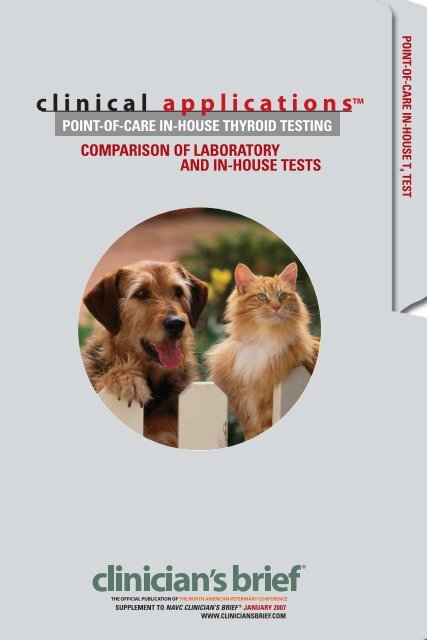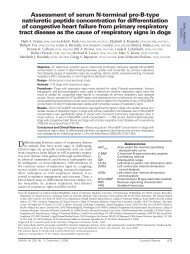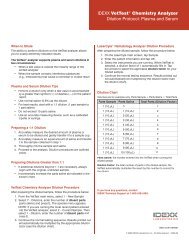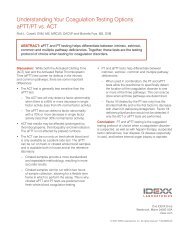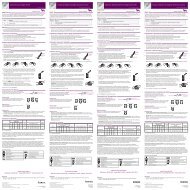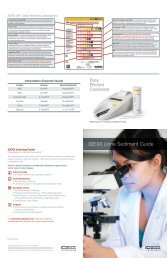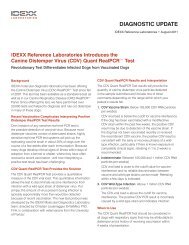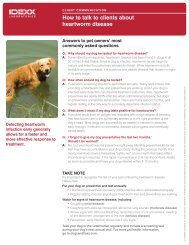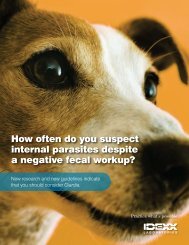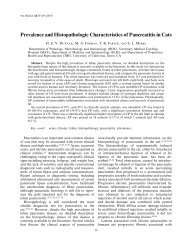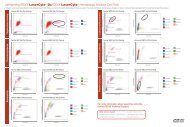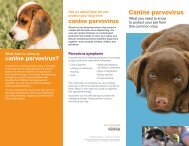Point-Of-Care in-house thyroid testing - IDEXX Laboratories
Point-Of-Care in-house thyroid testing - IDEXX Laboratories
Point-Of-Care in-house thyroid testing - IDEXX Laboratories
Create successful ePaper yourself
Turn your PDF publications into a flip-book with our unique Google optimized e-Paper software.
cl<strong>in</strong>ical applications<br />
POINT-OF-CARE IN-HOUSE THYROID TESTING<br />
COMPARISON OF LABORATORY<br />
AND IN-HOUSE TESTS<br />
THE OFFICIAL PUBLICATION OF THE NORTH AMERICAN VETERINARY CONFERENCE<br />
SUPPLEMENT TO NAVC CLINICIAN’S BRIEF ® JANUARY 2007<br />
WWW.CLINICIANSBRIEF.COM<br />
POINT-OF-CARE IN-HOUSE T 4 TEST
POINT-OF-CARE IN-HOUSE T 4 TEST<br />
2<br />
cl<strong>in</strong>ical applications <br />
POINT-OF-CARE IN-HOUSE THYROID TESTING<br />
COMPARISON OF LABORATORY<br />
AND IN-HOUSE TESTS<br />
This study<br />
demonstrates a<br />
good correlation<br />
between 4<br />
different methods<br />
of thyrox<strong>in</strong>e<br />
(T4 ) test<strong>in</strong>g.<br />
Thyroid disease is relatively common <strong>in</strong> dogs and cats;<br />
however, dogs are most commonly hypo<strong>thyroid</strong> while cats<br />
are most commonly hyper<strong>thyroid</strong>. The measurement of total<br />
thyrox<strong>in</strong>e (T 4 ) is the ma<strong>in</strong>stay for diagnos<strong>in</strong>g <strong>thyroid</strong> disease <strong>in</strong> both<br />
species and for evaluat<strong>in</strong>g therapeutic success. Dogs suspected of<br />
be<strong>in</strong>g hypo<strong>thyroid</strong> (borderl<strong>in</strong>e or low concentrations of T 4 ) usually<br />
also have confirmation tests to determ<strong>in</strong>e free T 4 and/or <strong>thyroid</strong><br />
stimulat<strong>in</strong>g hormone (TSH or thyrotrop<strong>in</strong>) concentrations. In cats<br />
suspected of be<strong>in</strong>g hyper<strong>thyroid</strong> (<strong>in</strong>creased concentration of T 4 ), the total T 4 is usually sufficient<br />
to diagnose the disease, while levels <strong>in</strong> the mid to upper portion of the reference range are<br />
considered suspicious and warrant further test<strong>in</strong>g (such as measurement of free T 4 ).<br />
Historically, radioimmunoassay (RIA) <strong>in</strong> the laboratory has been considered the gold standard<br />
of T 4 test<strong>in</strong>g, but new methods and technology advancements have made other affordable,<br />
convenient, and time-sensitive methods available. Most RIA procedures have been designed for<br />
people but have been validated for use <strong>in</strong> domestic animals, and a total T 4 RIA test kit is<br />
marketed specifically for dogs. ELISA-based and chemilum<strong>in</strong>escent systems processed <strong>in</strong><br />
commercial laboratories<br />
KEY POINTS – Fel<strong>in</strong>e & Can<strong>in</strong>e Thyroid Disease<br />
FELINE HYPERTHYROIDISM<br />
Most often caused by<br />
hyperfunction<strong>in</strong>g <strong>thyroid</strong><br />
gland nodules (secretion of T 4<br />
and T 3 not controlled by TSH)<br />
Common cl<strong>in</strong>ical signs<br />
■ Weight loss<br />
■ Polyphagia<br />
■ Vomit<strong>in</strong>g<br />
■ Tachypnea<br />
■ Hyperactivity<br />
■ Dyspnea<br />
Differential Diagnosis<br />
■ Chronic kidney disease<br />
■ Chronic liver disease<br />
■ Neoplasia<br />
Diagnosis<br />
■ Total T 4 concentration<br />
above reference range<br />
■ High normal total T 4<br />
coupled with elevated<br />
free T 4<br />
CANINE HYPOTHYROIDISM<br />
Most common <strong>in</strong> middle-aged<br />
dogs; acquired primary disease<br />
(lymphocytic <strong>thyroid</strong>itis or<br />
idiopathic <strong>thyroid</strong> atrophy)<br />
Common cl<strong>in</strong>ical signs<br />
■ Lethargy<br />
■ Inactivity<br />
■ Mental dullness<br />
■ Weight ga<strong>in</strong><br />
■ Hair loss or excessive shedd<strong>in</strong>g<br />
■ Recurrent <strong>in</strong>fections<br />
Differential Diagnosis<br />
■ Exclude other endocr<strong>in</strong>e<br />
diseases such as<br />
hyperadrenocorticism<br />
Diagnosis<br />
■ Total T 4 below reference range<br />
screen<strong>in</strong>g test<br />
■ Decreased free T 4<br />
■ Increased cTSH levels may<br />
be seen<br />
also have been validated for<br />
total T 4 concentration<br />
test<strong>in</strong>g <strong>in</strong> dogs and cats. A<br />
po<strong>in</strong>t-of-care <strong>in</strong>-<strong>house</strong><br />
ELISA system (<strong>IDEXX</strong><br />
SNAP ® T 4 Test) for use by<br />
veter<strong>in</strong>arians <strong>in</strong> a practice<br />
sett<strong>in</strong>g is also commercially<br />
available. The study<br />
presented on the opposite<br />
page compared results<br />
from these 4 methods of<br />
analysis and demonstrated<br />
a good correlation among<br />
them. The data give the<br />
practitioner a good basis<br />
for select<strong>in</strong>g among<br />
currently available T 4 test<strong>in</strong>g<br />
methods, provid<strong>in</strong>g a<br />
greater range of solutions<br />
than has been available <strong>in</strong><br />
the past.<br />
c l i n i c i a n ’ s b r i e f ®
STUDY – Compar<strong>in</strong>g various methods of T 4 test<strong>in</strong>g 1<br />
■ Serum samples obta<strong>in</strong>ed from 98 dogs and 100 cats<br />
■ Samples were submitted to diagnostic lab to test the follow<strong>in</strong>g:<br />
Dogs<br />
Screen<strong>in</strong>g for hypo<strong>thyroid</strong>ism 41<br />
Assess<strong>in</strong>g adequacy of treatment 39<br />
Reason for request unknown 18<br />
Cats<br />
Screen<strong>in</strong>g for hyper<strong>thyroid</strong>ism 64<br />
Assess treatment with methimazole 17<br />
Reason for request unknown 19<br />
■ 12 pairs (24 animals) for comparison of the 4 assay methods for 2 species<br />
■ Precision estimates were determ<strong>in</strong>ed for each assay us<strong>in</strong>g serially diluted dog and cat serum<br />
■ Samples submitted to a veter<strong>in</strong>ary university endocr<strong>in</strong>ology lab<br />
■ T 4 concentration determ<strong>in</strong>ed by RIA T 4 assay with<strong>in</strong> 1 of 4 ranges<br />
0.5 to 1.5 µg/dl 3.1 to 4.9 µg/dl<br />
1.6 to 3.0 µg/dl 5.0 to 7.0 µg/dl<br />
T 4 Assay Methods* †<br />
Method Test Performed by Product maker<br />
A Can<strong>in</strong>e total T4 coated-tube RIA<br />
Diagnostic laboratory Coat-A-Count Can<strong>in</strong>e Total T4 Diagnostic Products Corp<br />
Los Angeles, CA<br />
B In-<strong>house</strong> enzyme- In-<strong>house</strong> (simulated)* SNAP ® l<strong>in</strong>ked immunosorbent<br />
T4 <strong>IDEXX</strong> <strong>Laboratories</strong><br />
assay (ELISA) kit Westbrook, ME<br />
C** RIA total T4 kit Mailed to company Coat-A-Count Total T4 Diagnostic Products Corp<br />
Los Angeles, CA<br />
D** CEIA kit Mailed to company Immulite Total T4 Diagnostic Products Corp<br />
Los Angeles, CA<br />
* Performed by a veter<strong>in</strong>ary student.<br />
† Sensitivity was 0.15, 0.5, 0.25, and 0.4 µg/dl for assays A, B, C, and D respectively.<br />
** Marketed for human, validated for use <strong>in</strong> dogs and cats.<br />
RESULTS<br />
■ Statistical comparisons of T 4 test method results revealed, <strong>in</strong> general, good correlation between T 4<br />
concentrations.<br />
■ Agreement was generally excellent for T 4 concentrations <strong>in</strong> low to middle portion of cl<strong>in</strong>ically normal<br />
ranges.<br />
■ Divergent results were seen for all methods at higher T 4 concentrations, but it is possible that factors<br />
such as lipemia, hemolysis, or method of serum collection contributed to these differences.<br />
■ In general, the T 4 concentrations obta<strong>in</strong>ed by assay method A were lower than those of the other<br />
methods. These differences were more profound at higher concentrations, and <strong>in</strong> cats.<br />
Discussion<br />
For hypo<strong>thyroid</strong>ism <strong>in</strong> dogs, most veter<strong>in</strong>arians use total T 4 concentrations as screen<strong>in</strong>g tests. Because<br />
factors other than hypo<strong>thyroid</strong>ism can cause low total T 4 concentrations, confirmation tests are needed<br />
to make a diagnosis. This study showed that a po<strong>in</strong>t-of-care system (method B) provided reliable and<br />
consistent results for screen<strong>in</strong>g and for assess<strong>in</strong>g adequacy of T 4 replacement treatment.<br />
For hyper<strong>thyroid</strong>ism <strong>in</strong> cats, there was good agreement between methods for total T 4 concentrations<br />
above the reference range. Because some cats with hyper<strong>thyroid</strong>ism have total T 4 concentrations<br />
with<strong>in</strong> reference ranges, other test<strong>in</strong>g may be <strong>in</strong>dicated when <strong>thyroid</strong> disease is suspected but total T 4<br />
is with<strong>in</strong> the reference range.<br />
1. Measurement of total thyrox<strong>in</strong>e concentration <strong>in</strong> serum from dogs and cats by use of various<br />
methods. Kemppa<strong>in</strong>en RJ, Birchfield JR. Am J Vet Res 67:259-265, 2006.<br />
c l i n i c a l a p p l i c a t i o n s <br />
3<br />
POINT-OF-CARE IN-HOUSE T 4 TEST
4<br />
Commentary<br />
Can<strong>in</strong>e hypo<strong>thyroid</strong>ism and fel<strong>in</strong>e hyper<strong>thyroid</strong>ism are two of the most common endocr<strong>in</strong>e disorders<br />
seen <strong>in</strong> small animal practice. Because <strong>thyroid</strong> disorders typically respond well to therapy<br />
and have a good prognosis, it is important for the practitioner to be aware of both common and<br />
uncommon cl<strong>in</strong>ical signs and to rout<strong>in</strong>ely screen patients with suspected or potential disease.<br />
Serum total thyrox<strong>in</strong>e (T 4 ) concentrations commonly used for screen<strong>in</strong>g and therapeutic monitor<strong>in</strong>g<br />
are rout<strong>in</strong>ely offered by diagnostic laboratories us<strong>in</strong>g a radioimmunoassay or chemilum<strong>in</strong>escence test. The<br />
availability of an <strong>in</strong>-<strong>house</strong> T 4 test<strong>in</strong>g system can offer a convenient, cost-effective alternative. This study showed generally<br />
good correlation between the various methodologies and it appears that any of them, <strong>in</strong>clud<strong>in</strong>g the <strong>IDEXX</strong><br />
SNAP ® T 4 <strong>in</strong>-<strong>house</strong> test, is appropriate, dependable, and <strong>in</strong>dicated. It must be remembered that with any test, false<br />
negative and false positive results can occur for any number of reasons, and that results must be <strong>in</strong>terpreted <strong>in</strong><br />
light of the patient’s history, cl<strong>in</strong>ical signs, and other laboratory f<strong>in</strong>d<strong>in</strong>gs. — Peter P. K<strong>in</strong>tzer, DVM, DACVIM, Staff<br />
Internist, Boston Road Animal Hospital, Spr<strong>in</strong>gfield, Massachusetts<br />
SUGGESTED READING<br />
Can<strong>in</strong>e hypo<strong>thyroid</strong>ism. Dixon RM. BSAVA<br />
Manual of Can<strong>in</strong>e and Fel<strong>in</strong>e Endocr<strong>in</strong>ology,<br />
3rd ed. Mooney CT, Peterson ME. Gloucester,<br />
UK: BSAVA Publications, 2004, pp 76-94.<br />
Fel<strong>in</strong>e hyper<strong>thyroid</strong>ism. Mooney CT, Peterson<br />
ME. BSAVA Manual of Can<strong>in</strong>e and Fel<strong>in</strong>e<br />
Endocr<strong>in</strong>ology, 3rd ed. Mooney CT, Peterson<br />
ME. Gloucester, UK: BSAVA Publications, 2004,<br />
pp 95-111.<br />
Hypo<strong>thyroid</strong>ism. Feldman EC, Nelson RW.<br />
Can<strong>in</strong>e and Fel<strong>in</strong>e Endocr<strong>in</strong>ology and<br />
Reproduction (3rd ed). Feldman EC, Nelson<br />
RW. Philadelphia: WB Saunders Co, 2004, pp<br />
86-151.<br />
Measurement of serum concentrations of free<br />
thyrox<strong>in</strong>e, total thyrox<strong>in</strong>e, and total<br />
triiodothyron<strong>in</strong>e <strong>in</strong> cats with hyper<strong>thyroid</strong>ism<br />
and cats with non<strong>thyroid</strong>al disease. Peterson<br />
ME, Melian C, Nichols R. JAVMA 218:529-536,<br />
2001.<br />
© 2007 Educational Concepts<br />
<strong>IDEXX</strong> Product Profile<br />
<strong>IDEXX</strong> SNAP ® Reader<br />
■ Only <strong>in</strong>-<strong>house</strong> <strong>in</strong>strument that tests T 4, cortisol, &<br />
bile acids<br />
■ Easy to use<br />
■ Attaches to top of <strong>IDEXX</strong> VetTest ® Chemistry<br />
Analyzer, so no additional bench space needed<br />
■ Cost effective<br />
<strong>IDEXX</strong> SNAP ® T 4 test<br />
■ Diagnoses <strong>thyroid</strong><br />
disease<br />
■ Assesses geriatric<br />
preanesthetic cats<br />
■ Provides<br />
comprehensive, onevisit<br />
screen<strong>in</strong>g for cats, dogs, and horses<br />
■ Monitors response to treatment for immediate<br />
dosage adjustment<br />
This research summary is sponsored by an educational grant from <strong>IDEXX</strong> Corporation.<br />
09-65881-00<br />
c l i n i c a l a p p l i c a t i o n s


